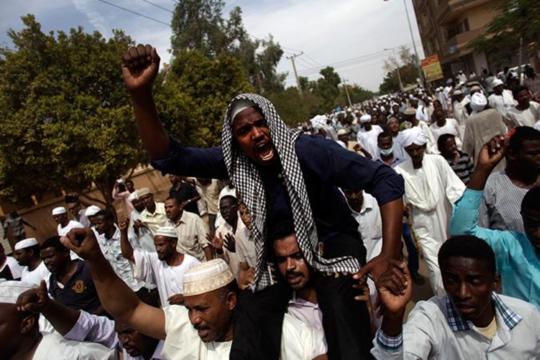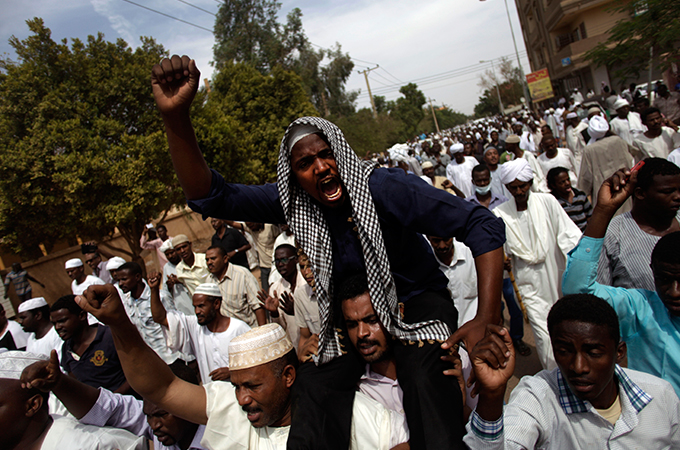
 |
|
Sudanese anti-government protesters chant slogans after the Friday noon prayer in the Omdurman district of northern Khartoum [AP ]
|
|
Abstract |
The Sudanese government decided to lift subsidies on basic commodities, resulting in price hikes where a gallon of fuel rose in price by sixty-eight per cent, from 12.5 to 21 Sudanese pounds, and the price of gas canisters rose increased by fifty-eight per cent, negatively impacting on the purchasing power of Sudanese people. They took to the streets to express their rage through protests and using slogans inspired by the Arab Spring. However, their demands were rejected by the Sudanese regime, which also denied the legitimacy of the protests. According to Amnesty International, the death toll is estimated at 200, and many demonstrators sustained gunshot wounds to the head and chest. The authorities declared that only thirty-four people were killed.
It is noteworthy that the majority of protesters were young people aged between twenty and thirty, who were born and raised under the National Salvation government which took power on 30 June 1989. The protests are a demonstration of the failure of the regime to convince these young people that their future is tied to the government’s continuing in power. Moreover, the youth are not involved in opposition organisations and did not live under the rule of any of them. Socially, they are the result of the moral, political and economic salvation system and their protest is a clear articulation of their current frustration and fear for their future.
Before announcing the decision regarding the reduction in subsidies, the Sudanese government tried to anticipate the people’s fury by communicating with various opposition groups, with the aim of explaining the reasons that forced it to raise prices. The finance minister met with leaders of national parties such as the Democratic Unionist Party and the Popular Congress Party, but failed to rally their support for his policies to address the situation. While the government focused on technical economic measures, the opposition gave priority to a political resolution.
The government also launched a widescale mass media campaign and held meetings for government-affiliated organisations led by the president, Omar al-Bashir. The meetings brought together women, students, and young people from the ruling National Congress Party (NCP), the army, police and the National Intelligence and Security Service (NISS). Most recommendations from these meetings unambiguously rejected the government’s measures. However, the government insisted on and continued with its decisions.
After its failure to rally support for its decision to raise prices, and after protests broke out, the government chose to crack down on protestors. The violence of protests in some areas provided the security authorities with a justification to regard the protests as a movement without legitimate political purpose whose only aim was to spread chaos. By cracking down on such protests, they hoped to deter others from joining.
Political consequences of the protests
The protests resulted in division within the ruling NCP, and its reformist wing sent Bashir a memorandum signed by thirteen leaders, including members of parliament, former ministers, veterans and others. The memorandum described the measures taken by security forces as being harsh, showing no mercy and compassion to the weak, and not considering the justice that the shari’ah calls for. The signatories called for an immediate end to these measures and warned Bashir that his ruling regime could not be more vulnerable than it was when the letter was sent to him. This dissension within the ruling party is not new. It began several years ago and continues to grow along with the expansion in security spending. The memorandum could lead to the dismissal of the reformists from the party, leaving it to the hardline leaders. However, if such a decision is taken, the party will lose the support of the reformists and the influence they represent.
The Sudanese opposition remained hesitant about participation in the protests and adopting the protestors’ demands. Several conflicting factors placed them in this position. On the one hand, the opposition continued to believe that initiative lies in the hands of the regime, and that relying on people in the streets was a grave risk because it was unsure of who the protesters represented, and was doubtful that they could maintain their unity when confronted by the authorities. On the other hand, the opposition also feared that certain opposition forces – particularly the Sudan Revolutionary Front (SRF)– may seize the opportunity presented by a regime weakening due to the protests, and may seize power.
The SRF did see the protests as an opportunity to weaken the regime, expand its bases, and convert itself from a coalition representing political parties to a national force beyond just parties. Therefore, it proposed the formation of an alliance, but failed to use the protests to make political gains because concerns were raised that, as an armed force, its involvement in the protests may give the regime a justification to use the armed force to crush the protests. On the other hand, the SRF is the group with the greatest possibility of seizing power if protests were successful in overthrowing the regime.
Major regional and international major powers are likely to have developed their positions on two considerations. First, they view the Sudanese regime in a negative light for several reasons, foremost among which is its policies in Darfur. Second, they fear that were the regime to be ousted, the ensuing situation could result in widening instability in the east Africa region. They fear that fall of the Sudanese regime could be seized as an opportunity by militant groups which would use Sudan as a launchpad for strike against Egypt or Chad, or for assisting jihadi groups in Somalia and Libya. In any event, Sudan is current suffering isolation from the international community, and major powers are more concerned about the successor to rather than the survival of the current regime.
The conclusion is that the resources of the Sudanese regime are dwindling, and it lacks the necessary power to obtain victory in the current crisis by resorting to the security option. It also suffers from growing isolation.
Possible Scenarios
Several scenarios can be predicted in the current context:
1- Scenario 1: The government realises the political constraints it faces, and therefore seeks to provide the necessary compromises to meet the opposition half way. This scenario is mostly probable because the government has witnessed the furious reaction to its policies and its fast declining political position. In this context, Bashir’s address at the Supreme Military Academy on 1 October 2013 is relevant. He said, ‘We extend our hands to all our brethren, partners of the nation, to reject violence and work together to establish peace and continuous stability, and to share responsibility and solidarity while we approach elections in a nation free of security problems or problems regarding daily life.’ Recent events have renewed the hope of the opposition in the potential for overthrowing the regime, and using the rage of the people and the isolation of the government as means to pressure the government and to make political gains. The opposition hopes, for example, that the regime might agree to form a transitional government where all groups including the armed movements, participate, and where the reconciliation government oversees an interim stage which prepares the country for free and fair elections within agreed-upon institutions and policies.
2- Scenario 2: The military leadership insists on its positions, increasing the chances of a civil war, particularly in light of the bitterness resulting from recent events as a result of the death tolls. These emotions, combined with the political crisis, providing a growing opportunity for armed movements to join anti-government protests. The militant SRF can provide only military assistance to the civilian uprising, which may increase the cycle of violence and result in a comprehensive civil war that tears the state and society apart, and leads to the Somalisation of Sudan.
3- Scenario 3: The government refuses to budge from its decision to cut subsidies, and tightens the security grip in order to silence the protestors. The demonstrations, however, continue, particularly since the beginning of the academic year has resulted in educational institutions – in addition to mosques –the major centres of mobilisation and launchpads for protests. The already-high death toll will increase, and the rage will expand to include new sectors. Government will be incapable of controlling the situation, and its failure, as well as the confusion in society, will encourage the opposition to fully engage in the protests. The country will enter a state of revolution that threatens the regime. The government will resort to the armed forces to impose security and stability, but the military leadership will refuse to kill protestors. The government will attempt to strike a deal with the opposition but it will be too late. Sudan will have already joined the wave of the Arab Spring.